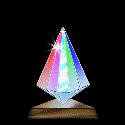|
Crystal and Gemstone Therapy
Healing Crystals and Gemstones are one of the most beautiful, mystical and
profound "energy medicine" tools, which have been used for centuries throughout all cultures, religions and empires. Crystals
bring amazing benefits to the healing arena!
Crystals are often
used for clearing your mind, helping with a physical problem, meditation, charms for protection for yourself or your home,
for healing, for chakra work, for stone elixirs, or for anything that seems suitable.

Candle Therapy
Using candles as therapy has been around for thousands of years, and has been
practiced by nearly every religion. Candle therapy can be used to unite the powers of mind, body, and spirit. From ancient
times to the present, Candles have lit our way through every transition! From celebrations and ceremonies to proclamations
and processions! The candle's flame has always been a metaphor for the soul! It possesses a tranquil and almost hypnotic atmosphere
to those who allow its power to take them to a very special place.
A candle acts as
a "self object". A self object is an object that is a reflection of our self, a reflection upon which we can act. The candle
reflects the spiritual and ethical changes we would like to bring about in ourselves. It burns as a reminder and symbol of
our desires.
Music Therapy
Music Therapy is the prescribed use of music and music related techniques to assist
and motivate a person towards specific, nonmusical goals. Music therapists use their training to effect changes in the cognitive,
physical, communication, social, and emotional skills. Music Therapy
utilizes music and music related activities to modify ineffective learning patterns, help to promote emotional, mental, social
and physical growth and to develop non-musical goals. Music Therapy works as a creative, flexible and sometimes spontaneous
means of utilizing the appeal of music to help people of all ages and abilities. Music Therapy is an established health
care profession that uses music and "techniques" in order to address physical, psychological, cognitive and social behavioral
patterns. Music Therapy can positively affect children and adults alike. Music Therapy can make the difference between
isolation and interaction and has been proven in situations such as:
depression, anger, pain, autism, stress, grief, loss, time management, motivation, growth, change, procrastination and improving communication
|
 |
|
|
|
|
Color Therapy
Color Healing, Light Therapy and Chromotherapy are all terms used interchangeably with Color Therapy, which is a set
of principles used to create harmonious color and color combinations for healing. This form of energy medicine is based on
the belief that the human body is composed of energy fields. When the energy is properly distributed and circulating freely,
the body is healthy. Imbalances or abnormal amounts of energy are believed to indicate an excess or deficency. Color is
energy. The energy vibration of that color is what you need, in the moment, in order to improve and balance your physical
and emotional state.
History of Color Therapy
Color therapy is a technique of restoring imbalance by means of applying
color to the body. It was a popular method of cure even in ancient times. Some 2,500 years ago, Pythagoras applied color light
therapeutically and `color halls' were used for healing in ancient Egypt, China and India.
The first color
wheel was invented by Sir Isaac Newton. He split white sunlight into red, orange, yellow, green, cyan, and blue. He then joined
the two ends of the color spectrum together to show the natural
progression of colors. Newton went a step further and associated each color with a musical note.
Johann Wolfgang Goethe began studying psychological effect of colors
about a century after Newton. Goethe created a color wheel showing the psychological effect of each color. He divided all
the colors into two groups: the plus group (red, orange, yellow) and the minus group (green, blue, indigo, violet). Colors
of the plus group produce excitement and cheerfulness. Colors of the minus group are associated with weakness and unsettled
feelings. Goethe observed that blue gives a feeling of coolness and yellow has a warming effect.
The pioneer of
modern color therapy was Niels Finsen of Denmark. Following the discovery, in 1877, of the bactericidal action of solar
ultra-violet energy, Finsen studied the possibility of assisting the healing of wounds with visible light. He subsequently
used red light to inhibit the formation of smallpox scars and, in 1896, founded a Light Institute ( now the Finsen Institute
of Copenhagen) for the phototreatment of tuberculosis. In 1932, Gerrard and Hessay, two Californian psychologists,
scientifically established that:
• blue light has a calming effect
• red light has a stimulating power on human beings.
Blue and red colors are considered at the two extremes with yellow
representing the midpoint. These are also the three principal colors in a rainbow.
Every substance on earth contains color. Even the rays cast on earth by celestial bodies contain color
in the form of white light. The rays of the sun contain seven different colors - violet, indigo, blue, green, yellow, orange
and red. These are natural colors which are highly beneficial to the maintenance of health and for healing diseases.
|
 |
|
|
|
|


